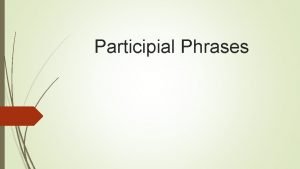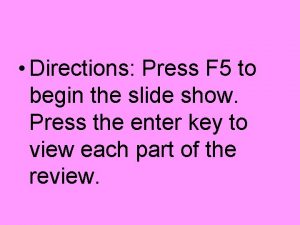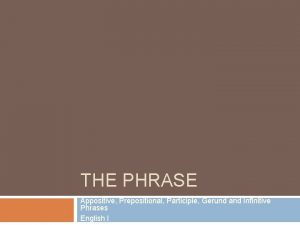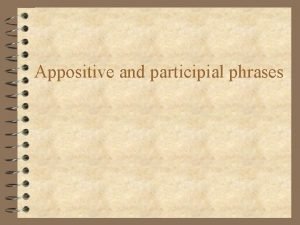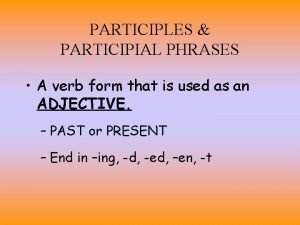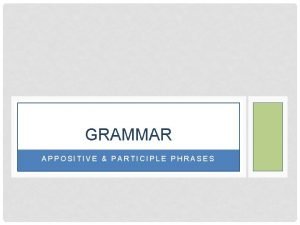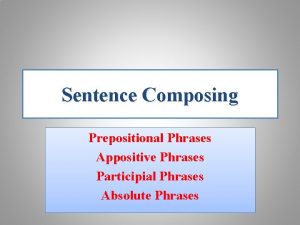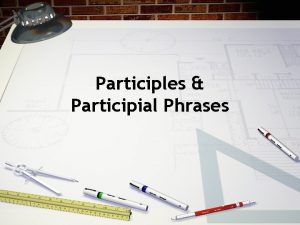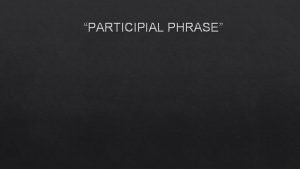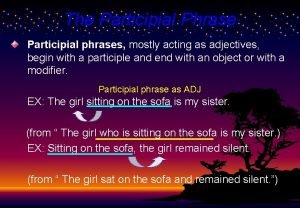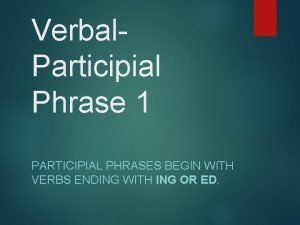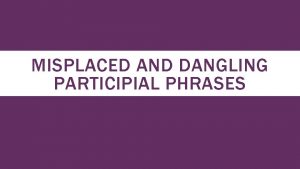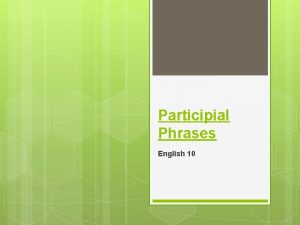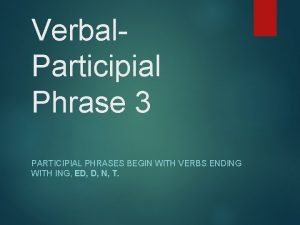Participial Phrases PARTICIPIAL PHRASE A participle is a









- Slides: 9

Participial Phrases

PARTICIPIAL PHRASE A participle is a verb form that functions as an adjective by modifying nouns and pronouns. A participle can be either a present participle or a past participle. A participial phrase includes the participle, plus any modifiers and complements.

When a participle phrase introduces a main clause, separate the two sentence components with a comma. The pattern looks like this: PARTICIPLE PHRASE + , + MAIN CLAUSE. Example: Glazed with barbecue sauce, the rack of ribs lay nestled next to a pile of sweet coleslaw.

When a participle phrase concludes a main clause and is describing the word right in front of it, you need no punctuation to connect the two sentence parts. The pattern looks like this: MAIN CLAUSE + Ø + PARTICIPLE PHRASE. Example: Mariah risked petting the pit bull wagging its stub tail.

But when a participle phrase concludes a main clause and modifies a word farther up in the sentence, you will need a comma. The pattern looks like this: MAIN CLAUSE + , + PARTICIPLE PHRASE. Example: Cooper enjoyed dinner at Audrey's house, agreeing to a large slice of cherry pie even though he was full to the point of bursting.

Present Tense Shivering, the couple ran out of the rain and into the house. (Shivering is the present participle. It modifies couple. ) The sobbing child held his injured knee. (Sobbing is the present participle. It modifies child. ) Sweeping across the night sky, the bats hunted their prey. (Sweeping is the present participle, and sweeping across the night sky is the participial phrase. The participial phrase modifies bats. )

Past Tense The broken window needed to get repaired quickly. (Broken is the past participle. It modifies window. ) To make the batter, stir the beaten eggs into the flour. (Beaten is the past participle. It modifies eggs. ) Excited about dinner, Hari ran the whole way home. (Excited is the past participle, and excited about dinner is the participial phrase. The participial phrase modifies Hari. )

Dangling Phrases A participial phrase should refer clearly to a noun or pronoun in the sentence. We need to be careful when combining sentences such as these: I curled my toes and squinted. The doctor prepared to puncture my arm with a needle. Notice what happens if we drop I and change the first sentence to a participial phrase: Curling my toes and squinting, the doctor prepared to puncture my arm with a needle.

Here the participial phrases refer to the doctor when they should refer to I--a pronoun that's not in the sentence. This kind of problem is called a dangling modifier. We can correct this dangling modifier either by adding I to the sentence or by replacing the participial phrase with an adverb clause: Curling my toes and squinting, I waited for the doctor to puncture my arm with a needle. As I curled my toes and squinted, the doctor prepared to puncture my arm with a needle.
